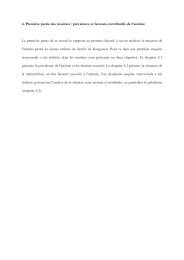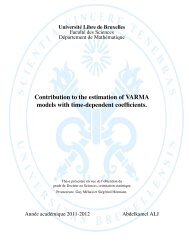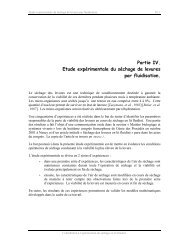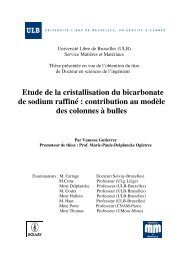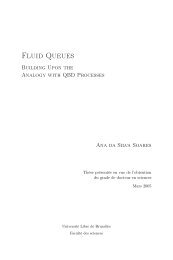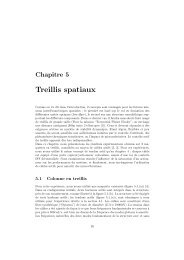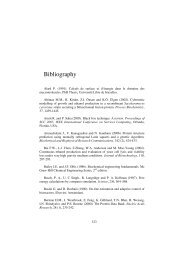Diapositive 1 - de l'Université libre de Bruxelles
Diapositive 1 - de l'Université libre de Bruxelles
Diapositive 1 - de l'Université libre de Bruxelles
Create successful ePaper yourself
Turn your PDF publications into a flip-book with our unique Google optimized e-Paper software.
Chapitre VA quadratic modulation of the magnesium incorporation in the precipitated minerals bythe protein concentration was observed at Mg/Ca solution ≥ 3. The magnesium incorporationwas higher at a protein concentration of 5 µg/ml than at 1 and 10 µg/ml. This could belinked to the inhibitory effect of high concentrations of organic matrix on calciumcarbonate nucleation, as <strong>de</strong>scribed in numerous studies (Wheeler & Sikes 1984, Wilbur &Bernhardt 1984, Addadi & Weiner 1985, Wheeler et al 1988).The observed enhancement of magnesium incorporation in presence of genuine organicmatrix compared to controls without matrix was maximal in the precipitation experimentsperformed at a 3:1 Mg/Ca solution with a protein concentration of 5 µg/ml, for both matrixextracts. In these treatments, precipitated minerals were richer by 9 mol% MgCO 3 thanthose precipitated in absence of additive. This excee<strong>de</strong>d consi<strong>de</strong>rably the enhancementvalues (3 mol% MgCO 3 ) obtained in vitro with the addition of a simple biomimeticpepti<strong>de</strong> by Stephenson et al (2008). The extracted organic matrix macromolecules presenttherefore a stronger ability to enhance magnesium incorporation into calcium carbonatethan synthetic molecules.We do notice that our results differed from those of Raz et al (2003), who did not observean increase of magnesium incorporation in minerals precipitated in presence of organicmatrix macromolecules extracted from sea urchin larval spicules. We suggest that thisabsence of effect could be due to either the low Mg/Ca solution (2:1) used by these authors,or to the lyophilization to dryness of the SOM which could have affected theconformation of these macromolecules. The differences observed from the results ofFalini et al (1994) are probably linked to the analytical method, XRD, that did not takeinto account magnesium in the amorphous phase.The morphology of in vitro precipitated minerals was relatively similar to that <strong>de</strong>scribedin the literature. The magnesium induced curvation of crystal edges was already reportedby Meldrum & Hy<strong>de</strong> (2001). The elongation of crystal along the c-axis in presence oforganic additives was observed by Albeck et al (1993, 1996) and Meldrum & Hy<strong>de</strong>(2001). The dumbbell shaped minerals have been characterized as magnesium calcite(Raz et al 2000, Meldrum & Hy<strong>de</strong> 2001, Gayathri et al 2007). Peanut like <strong>de</strong>posits werereported by Loste et al (2003). Spherical particles similar to those observed in this studyat high Mg/Ca solution were reported in previous studies (Han et al 2005, Kwak et al 2005,Cheng et al 2007) and characterized as a mixture of calcite and ACC with high106



